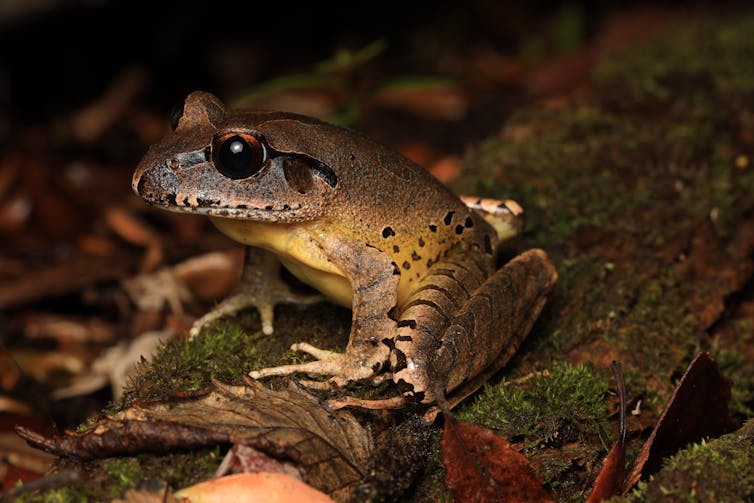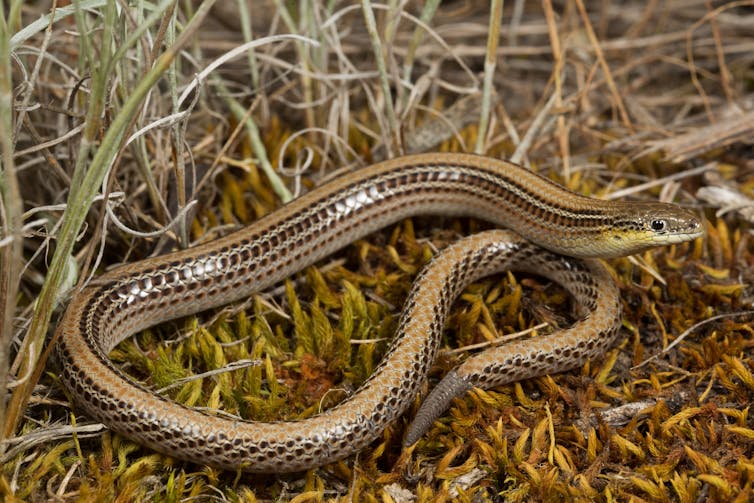- Home
Edition
Africa Australia Brasil Canada Canada (français) España Europe France Global Indonesia New Zealand United Kingdom United States Edition:
Global
Edition:
Global
- Africa
- Australia
- Brasil
- Canada
- Canada (français)
- España
- Europe
- France
- Indonesia
- New Zealand
- United Kingdom
- United States
 Academic rigour, journalistic flair
Academic rigour, journalistic flair
 Nicolas Rakotopare, CC BY-ND
New data reveals how Australia’s threatened reptiles and frogs are disappearing – and what we have to do
Published: November 25, 2025 5.39am GMT
Geoffrey Heard, The University of Queensland, Australian National University, Sarah McGrath, The University of Queensland, Tayla Lawrie, The University of Queensland
Nicolas Rakotopare, CC BY-ND
New data reveals how Australia’s threatened reptiles and frogs are disappearing – and what we have to do
Published: November 25, 2025 5.39am GMT
Geoffrey Heard, The University of Queensland, Australian National University, Sarah McGrath, The University of Queensland, Tayla Lawrie, The University of Queensland
Authors
-
 Geoffrey Heard
Geoffrey Heard
Science Advisor, TSX, The University of Queensland; Australian National University
-
 Sarah McGrath
Sarah McGrath
Senior Project Officer, Threatened Species Index, The University of Queensland
-
 Tayla Lawrie
Tayla Lawrie
Project Manager, Threatened Species Index, The University of Queensland
Disclosure statement
Geoffrey Heard works for The University of Queensland on the Threatened Species Index project, a key part of the Terrestrial Ecosystem Research Network (TERN). TERN is funded by the Australian Government, through the National Collaborative Research Infrastructure Strategy.
Sarah McGrath is a current employee of the Terrestrial Ecosystem Research Network (TERN), funded by the National Collaborative Research Infrastructure Strategy.
Tayla Lawrie is a current employee of the Terrestrial Ecosystem Research Network (TERN), funded by the National Collaborative Research Infrastructure Strategy.
Partners
University of Queensland and Australian National University provide funding as members of The Conversation AU.
View all partners
DOI
https://doi.org/10.64628/AA.ku39xd5vc
https://theconversation.com/new-data-reveals-how-australias-threatened-reptiles-and-frogs-are-disappearing-and-what-we-have-to-do-270253 https://theconversation.com/new-data-reveals-how-australias-threatened-reptiles-and-frogs-are-disappearing-and-what-we-have-to-do-270253 Link copied Share articleShare article
Copy link Email Bluesky Facebook WhatsApp Messenger LinkedIn X (Twitter)Print article
Australia is home to extraordinary reptiles and frogs, from giant lace monitors to tiny alpine froglets. Over 1,100 reptiles and 250 frog species are found across the Australian continent and islands. But we are losing them.
So far, one of Australia’s reptiles has become extinct, the delicate Christmas Island forest skink. And seven frogs are thought to be lost forever, including the only two species of gastric brooding frog – famous for their ability to brood their young in the female’s stomach.
We wanted to know how are other frogs and reptiles were faring. So, for the first time, we asked frog and reptile experts to contribute to the Threatened Species Index (TSX). This index uses robust and reliable data to measure changes in the relative abundance of Australia’s threatened and near-threatened species.
In all, we compiled data for 28 species of frogs and 24 species of reptiles. Unfortunately, the results were sobering. The first national monitoring dataset reveals their numbers have declined by 96% on average since 1985.
 The endangered Fleay’s barred frog.
Geoff Heard, CC BY-ND
The endangered Fleay’s barred frog.
Geoff Heard, CC BY-ND
Steep declines
First, we urge caution with these findings because key datasets are yet to be included. But the trends are concerning.
Among the species and populations we gathered data for, declines among reptiles and frogs are steep: 94% on average for reptiles and 97% for frogs since 1985.
 The change in the relative abundance of different taxon groups, as collated by the Threatened Species Index.
The change in the relative abundance of different taxon groups, as collated by the Threatened Species Index.
These substantial declines were evident even when using more recent reference years. For example, with a reference year of 2000, the average decline remains 88% for reptiles and 62% for frogs. Declines since 1985 have been far greater for reptiles and frogs than for the birds, mammals and plants included in the index to date.
Why is this happening?
For threatened reptiles, the drop in numbers has many causes. Disease-causing pathogens are responsible for some, such as Bellinger River saw-shelled turtles, which have declined due to a novel virus.
Others, including Merten’s water monitors and Mitchell’s water monitor in northern Australia, are being affected by invasive species, such as toxic cane toads. Grassland reptiles continue to lose habitat to clearing.
For frogs, the severe declines started when the invasive “chytrid fungus” spread across Australia in the 1980s. This fungus, which has decimated frog populations globally, caused the seven frog extinctions in Australia.
For the first time, we gathered national data on the numbers of reptile and frog species. The findings were worrying.However, while several species hit hard by chytrid have recovered, other species have continued to decline. For example, data collated so far suggests declines in frog species not affected by chytrid fungus are steeper in recent years than for species affected by the fungus.
This likely reflects a weakening of disease impacts for some species. And other threats – such as bushfires, droughts and invasive species – having intensified for several frog species left largely untouched by chytrid fungus.
First national snapshot
In order to protect endangered species, we need to know the extent of the problem. The Threatened Species Index is the only national tool that aggregates data on the abundance of imperilled animals and plants.
Last year, we set out to broaden the index by including data on frogs and reptiles for the first time. We contacted scientists who study amphibians and reptiles across the country, many who have toiled for years collecting data on threatened species in remote locations. We also trawled the published and unpublished literature and scraped monitoring data from graphs and tables.
In all, we compiled data for 28 species of frogs and 24 species of reptiles, for a total of 894 monitoring time-series (“time-series” are repeated counts of a species at a particular location through time). While this number pales when compared to the number of time-series available for other groups (for example, more than 20,000 for birds), it’s a solid start.
 A striped legless lizard, a threatened reptile species.
Geoff Heard, CC BY-ND
A striped legless lizard, a threatened reptile species.
Geoff Heard, CC BY-ND
Working for recovery
Helping threatened species to thrive again is possible. For example, mammals we track in the index benefited from active conservation. Measures like controlling feral foxes or restoring habitat led to relatively stable mammal populations overall, declining by only 18% on average since 1990. But populations of mammals without direct conservation support have declined by 45% on average since 1990.
The pattern for plants is even more stark: threatened plant populations that are actively being conserved have increased by 2% on average since 1990, while those receiving no known intervention have declined by 81% on average.
These statistics show that with good management, turning around frog and reptile declines is possible. We have direct evidence of this too, such as the recovery of the Great Desert skink in central Australia that has benefited from fire management by Indigenous ranger groups.
In coming years, we will gather more data to provide a clearer picture of which animals and plants are recovering and which continue to decline. Collaboration between scientists, land managers and citizen scientists is vital to filling data gaps.
When Australians share observations through citizen science programs such as FrogID and iNaturalist, and support long-term monitoring, they can play a direct and meaningful role in safeguarding the future of our biodiversity.
- Extinction
- Mammals
- Reptiles
- Frogs
- Environment
Events
Jobs
-
 Analyst, Student Information and Regulatory Reporting
Analyst, Student Information and Regulatory Reporting
-
 Lecturer in Paramedicine
Lecturer in Paramedicine
-
 Associate Lecturer, Social Work
Associate Lecturer, Social Work
-
 Lecturer, Communication Design
Lecturer, Communication Design
-
 Leading Research Centre Coordinator
Leading Research Centre Coordinator
- Editorial Policies
- Community standards
- Republishing guidelines
- Analytics
- Our feeds
- Get newsletter
- Who we are
- Our charter
- Our team
- Partners and funders
- Resource for media
- Contact us
-
-
-
-
Copyright © 2010–2025, The Conversation

 Analyst, Student Information and Regulatory Reporting
Analyst, Student Information and Regulatory Reporting
 Lecturer in Paramedicine
Lecturer in Paramedicine
 Associate Lecturer, Social Work
Associate Lecturer, Social Work
 Lecturer, Communication Design
Lecturer, Communication Design
 Leading Research Centre Coordinator
Leading Research Centre Coordinator



